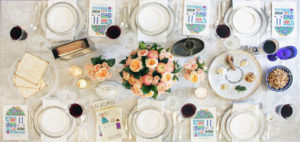 Many, many years ago, my husband and I would host the first Seder for our family in our apartment and then walk to Cooki’s house the next day to spend the second Seder with her family. Cooki’s husband Barry was my PhD supervisor and my husband and I spent many Shabbats and holidays at their table, in many ways learning and growing alongside their sons and daughters in law.
Many, many years ago, my husband and I would host the first Seder for our family in our apartment and then walk to Cooki’s house the next day to spend the second Seder with her family. Cooki’s husband Barry was my PhD supervisor and my husband and I spent many Shabbats and holidays at their table, in many ways learning and growing alongside their sons and daughters in law.
As the first day of Yom Tov ended and we started to get ready for the second Seder, I offered to set the table. As Cooki showed me where to find the cutlery, she had one instruction that has stuck with me ever since. She asked me to make sure the that the cutlery within each place setting matched.
Over the years, as families grow, it is common to add on to Passover dish sets to accommodate increasing numbers of guests at the Seders. I am grateful someone had the forethought to guide me to purchase plain white dishes for this purpose. Over the last twenty-five years, I have added to them several times, buying new white dishes and new settings of cutlery, never matching the exact pattern of my original set.
The same was true at Cooki’s house. There were several different sets of cutlery at the Seder table. While many of the men in the house (lovingly) mocked this stringency – that each place setting should contain a fork, knife and spoon of the same pattern – I saw nothing humorous or absurd in the request.
And I knew I would have the same rule in my own house.
In this week’s parshah, we are taught that every morning the Priest began his day by removing the ashes from the offering that burned throughout the night. However, there was more to the ritual than the simple chore of taking out the garbage:
The priest shall dress in linen raiment, with linen breeches next to his body; and he shall take up the ashes to which the fire has reduced the burnt offering on the altar and place them beside the altar. He shall take off his vestments, and put on other vestments, and carry the ashes outside the camp to a clean place.
The priest would put on his special clothes to remove the ashes from the altar. Then he would put the ashes down next to the altar, change out of the ritual clothing into something else, and then take the ashes out of the Tent and outside the camp.
What are we meant to learn from these minutiae of detail with regards to disposing of the leftover ash from the previous day’s sacrifice? We learn that each and every task and chore has the potential for meaning and holiness, if we approach it with the right attitude and if we attribute to it significance and value.
Setting a beautiful table for the holiday and for Shabbat always enhances the mitzvot we are observing, and the “added value” is in the details. There is much eye-rolling in my house when my request for help setting the table is followed by a brief lesson on cutlery patterns and insistence that each setting match.
It doesn’t bother me. The holidays – and especially Passover – are filled with many, many (many) mundane chores. We elevate them from the banal and tiresome when we take pride in our tasks and lend meaning to the details. If removing leftover ash formed part of the priest’s sacred duties, then even the cutlery can contribute to the holiness of Passover.
Wishing you a happy and kosher Passover.
Shabbat Shalom.



